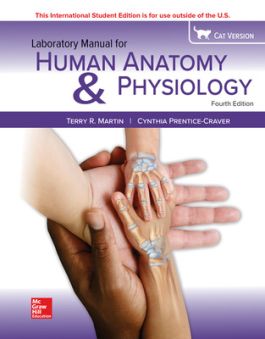ISE Laboratory Manual for Human Anatomy & Physiology Cat Version
Receive via shipping:
- Colour, print bound version of the complete text
Fundamentals of Human Anatomy and Physiology
1 Scientific Method and Measurements
2 Body Organization, Membranes, and Terminology
3 Chemistry of Life
4 Care and Use of the Microscope
Cells
5 Cell Structure and Function 6 Movements Through Membranes 7 Cell Cycle
Tissues
8 Epithelial Tissues 9 Connective Tissues
10 Muscle and Nervous Tissues
Integumentary System
11 Integumentary System
Skeletal System
12 Bone Structure and Classification
13 Organization of the Skeleton
14 Skull
15 Vertebral Column and Thoracic Cage
16 Pectoral Girdle and Upper Limb
17 Pelvic Girdle and Lower Limb
18 Fetal Skeleton
19 Joint Structure and Movements
Muscular System
20 Skeletal Muscle Structure and Function
21 Electromyography: BIOPAC Exercise
22 Muscles of the Head and Neck
23 Muscles of the Chest, Shoulder, and Upper Limb
24 Muscles of the Vertebral Column, Abdominal Wall, and Pelvic Floor
25 Muscles of the Hip and Lower Limb Laboratory
Surface Anatomy
26 Surface Anatomy
Nervous System
27 Nervous Tissue and Nerves
28 Spinal Cord, Spinal Nerves, and Meninges
29 Reflex Arc and Reflexes
30 Brain and Cranial Nerves
31 Electroencephalography: BIOPAC Exercise
32 Dissection of the Sheep Brain
General and Special Senses
33 General Senses
34 Smell and Taste
35 Eye Structure
36 Visual Tests and Demonstrations
37 Ear and Hearing
38 Ear and Equilibrium
Endocrine System
39 Endocrine Structure and Function
40 Diabetic Physiology
Cardiovascular System
41 Blood Cells
42 Blood Testing
43 Blood Typing
44 Heart Structure
45 Cardiac Cycle
46 Electrocardiography: BIOPAC Exercise
47 Blood Vessel Structure, Arteries, and Veins
48 Pulse Rate and Blood Pressure Lymphatic System
49 Lymphatic System
Respiratory System
50 Respiratory Organs
51 Breathing and Respiratory Volumes 52 Spirometry: BIOPAC Exercise
53 Control of Breathing
Digestive System
54 Digestive Organs
55 Action of a Digestive Enzyme
Urinary System
56 Metabolism
57 Urinary Organs
58 Urinalysis
Reproductive Systems and Development
59Male Reproductive System
60 Female Reproductive System
61 Meiosis, Fertilization, and Early Development
McGraw-Hill Connect is an award-winning digital teaching and learning solution that empowers students to achieve better outcomes and enables instructors to improve course management efficiency.
High-Quality Course Material
Our trusted solutions are designed to help students actively engage in course content and develop critical higher-level thinking skills while offering you the flexibility to tailor your course to the ways you teach and the ways your students learn.
Assignments & Automatic Grading
Connect features a question bank that you can select from to create homework, practice tests and quizzes. Dramatically reduce the amount of time you spend reviewing homework and grading quizzes, freeing up your valuable time to spend on teaching.
Analytics & Reporting
Monitor progress and improve focus with Connect’s visual and actionable dashboards. Reports are available to empower both instructors and students with real-time performance analytics.
Seamless Integration
Link your Learning Management with Connect for single sign-on and gradebook synchronization, with all-in-one ease for you and your students.


